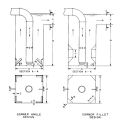Stilling Well Examples: Difference between revisions
From ASDSO Dam Safety Toolbox
No edit summary |
No edit summary |
||
| Line 10: | Line 10: | ||
'''The disadvantages of the vertical stilling well include:''' | '''The disadvantages of the vertical stilling well include:''' | ||
*Requires a steel liner to reduce the potential for damage to the pedestal and lower portion of the chamber. In some cases, the [[anchorage]] for the steel liner has been determined to be underdesigned for the conditions actually experienced. | *Requires a steel liner to reduce the potential for damage to the pedestal and lower portion of the chamber. In some cases, the [[anchorage]] for the steel liner has been determined to be underdesigned for the conditions actually experienced. | ||
*Problems have been experienced with the valve operating | *Problems have been experienced with the valve operating mechanism due to turbulence in the stilling well. | ||
*The typical valve and stilling well application is not well suited for use with high debris loads. | *The typical valve and stilling well application is not well suited for use with high debris loads. | ||
<gallery mode="slideshow" > | <gallery mode="slideshow" > | ||
Latest revision as of 23:41, 14 December 2022
The advantages of a vertical stilling well include:
- Minimal requirement for water levels within the downstream channel.
- Adaptable to sites with limited space due to other infrastructure restrictions.
- Inclusion of a sleeve valve may allow for more economy of savings than other alternatives.
The disadvantages of the vertical stilling well include:
- Requires a steel liner to reduce the potential for damage to the pedestal and lower portion of the chamber. In some cases, the anchorage for the steel liner has been determined to be underdesigned for the conditions actually experienced.
- Problems have been experienced with the valve operating mechanism due to turbulence in the stilling well.
- The typical valve and stilling well application is not well suited for use with high debris loads.
Note: The content on this page was originally created as part of DamOutletWorks.org (DOWL, 2018). It has subsequently been updated and reformatted as part of the Dam Safety Toolbox.
Revision ID: 5759
Revision Date: 12/14/2022





